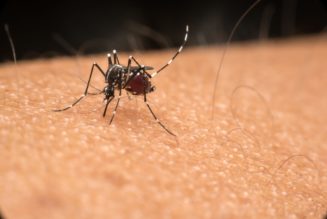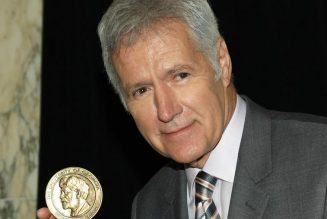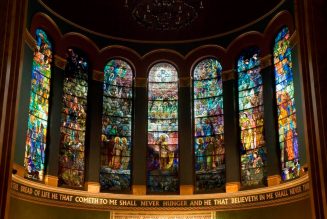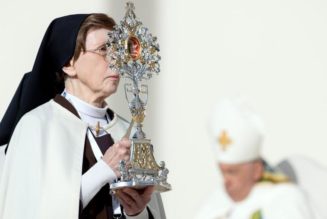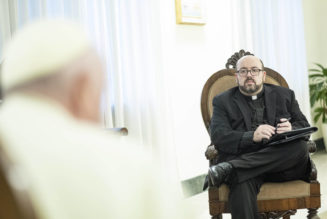Pillar subscribers can listen to this Pillar Post here: The Pillar TL;DR
Hey everybody,
I hope a lot of you enjoyed seeing the aurora borealis over the weekend, if the phenomenon could be seen where you live.

Here in Colorado, we’ve had a lot of cloud cover for the past few nights, and despite the solar storm that put them in reach for much of the country, the Northern Lights were never going to be especially visible from here anyhow.
But while much of the U.S. has enjoyed the experience of dazzling celestial displays, I did a little bit of reading about the Northern Lights.
When I went down that rabbit hole, I learned about something called the 1859 Carrington Event, the most intense geomagnetic storm in recorded human history.
For two days in September 1859, the event led to visible auroras all around the planet, even in equatorial countries like Colombia — to unbelievable light shows near everywhere across the sky.
Some newspapers record miners waking up at 1 a.m., with the sky so illuminated they believed it was morning. Others record extraordinary displays of color and light stretching across the sky.
Some people saw an ominous warning in the sky, and some church congregations gathered to pray ahead of the Armageddon they believed was coming.
In a phenomenon like the Carrington Event, electric current is induced from a charged electromagnetic field in the earth’s atmosphere.
Today, that kind of current would disable the global power grid — at least temporarily — causing blackouts and blowouts around the world.
Dependent as we are upon electricity, if we have another Carrington Event the humanitarian consequences could be catastrophic.
But in 1859, the world was not yet electrified. This meant that the main disruption caused by the current came to the world’s telegraph stations. I don’t really know enough about electricity to describe this well, but I can tell you what happened.
Because of the Carrington Event, there was too much current in the telegraph lines that crisscrossed the U.S. and Europe. Telegraph operators were getting shocked when they touched their machines.
They responded in two different ways. Some figured out that if they turned off the batteries connected to the telegraph machines, they could transmit messages using only the geomagnetically induced current carried in the lines. Telegraph records show those guys remarking to each other how unusual the situation was, and then getting back to work transmitting ordinary telegraph messages back and forth.
But another group of telegraph operators, after getting electrically shocked, told their bosses that the machines were unstable, and wouldn’t be operable for a couple of days. If they knew about the turn-off-the-battery trick, they didn’t say anything. Instead, they let the messages pile up, and went outside to watch the sky turn brilliant colors.
You can decide who chose the better part.
The news
Pitt Green is a co-founder of Spirit Fire, a fellowship of survivors which aims to help foster healing and growth in response to sexual abuse in the Church. The group walks with survivors, works with bishops, and talks with just about anyone who needs it, aiming to witness to their experience of abuse, and their own desires for healing.
For a lot of Catholics, Pitt Green became well-known when she spoke to the U.S. bishops at their fall 2018 plenary meeting, telling them the story of how clergy abuse had caused harm in her life, and how she had found healing in the Eucharist.
“My name is Teresa,” she told them. “I am a daughter of the Most High God. I am also a survivor of child sexual abuse, from when I was very young, over a number of years, by more than one priest.”
It was a powerful speech. But it was the tip of the iceberg for Pitt Green’s work, which sees her deeply engaged in efforts to reform leadership culture in the life of the Church, and to help fellow victims search for peace.
Ahead of her honorary doctorate on Saturday, Pitt Green talked with The Pillar.
“A lot of people think that when we heal, there won’t be mental illness, or that when we heal, there won’t be residual physical impact, or there won’t be triggers,” she told us.
“But the fact is, there is something remarkable about integrating your wounds into who you are. It won’t always be easy, but it’s finding the beauty and the love and the light that can come from them, and finding other people to share that with.”
“And the world is cruel because the world won’t always give you permission to do that. And the Church can be cruel on this. I know that firsthand.”
“I am grateful. I do function compared to what other people struggle with, but I want everyone to know that we should be careful about how we think of healing. That healing doesn’t mean going back to being some healthy, athletic, perfect person.”
“We’re asked to be broken and that’s why we love.”
Those insights were just one part of an important conversation.
advertisement:
Hozana is a social prayer network that lets Catholics create or join prayer communities for special intentions, and unite in prayer around the world. Pray the Rosary in groups of 5 with friends and family in a Living Rosary group for a special intention during the month of May!
The Franciscan Friars of the Renewal announced on Friday the laicization of Louis Leonelli — a once prominent priest, who was in 2022 accused of committing forcible sexual acts against a woman who was his spiritual directee, according to reporting that year from The Pillar.
Leonelli faced a canonical trial, ostensibly for the crime of sexual solicitation in the context of the confessional, though the extent of charges against him in that trial is not yet clear.
The now laicized friar was not expelled from the CFRs, but has requested from the Vatican a dispensation from his religious vows.
How did the process work?
—
In March 2022, The Pillar reported that Brooklyn auxiliary Bishop Raymond Chappetto was subject to a Vatican-ordered Vos estis lux mundi investigation, on charges that he had not acted sufficiently on information related to a predatory priest in the diocese.
The Brooklyn diocese told The Pillar last week that the investigation into Chappetto has concluded at the Vatican, with a finding that the allegations against him are “manifestly unfounded.”
The diocese told The Pillar that it was not privilege to the details of the Vos estis investigation, meaning that it couldn’t say — because it didn’t apparently know — what the investigators and the Vatican concluded was “unfounded” about the allegations against Chappetto.
That puts this case in a relatively standard situation for Vos estis investigation in the U.S. We know the allegations, and we know that the Vatican ordered an investigation and then cleared the accused bishop. But as to the whys and hows — well, on that front, we have very little detail, despite the fact that Vos estis was intended to create a transparent and accountable system of justice.
Here’s what that indicates to me: At some point, either this process will have to be reformed, or else too many times hearing “trust us, we investigated, but we can’t tell you anything” will mean that the stated aims of Vos estis have been defeated by an opaque process in which Catholics are asked to trust, without actual evidence of its rigors, methodologies, or objectivity.
Which is too bad for people like Bishop Chappetto, who insist on their innocence, but have only a relatively opaque process upon which to hang their hats.
The Pillar spoke with Fr. Moses Iorapuu of the Makurdi diocese, about the challenge of securing a high school in a place where terrorist and banditry violence have become the norm, and the government is uncooperative.
So what’s this Mass all about? Why did the bishops approve it?
Astute readers of The Pillar know that the Syro-Malabars have had some serious difficulties in recent years, especially in sometimes-violent conflicts regarding their liturgy, the Holy Qurbana.
In remarks during his audience, Pope Francis warned about the “dangerous temptation,” with regard to the liturgy, “to focus on one detail, and an unwillingness to let it go, even to the detriment of the good of the Church.”
But it also occurs to me to note why Catholics are so prone to argue about the liturgy. We do it because worship matters. And that shouldn’t be dismissed too easily.
I’ve often heard it said by divorced people that while their infighting was difficult on their families, it was when they stopped fighting that things felt beyond recovery — that neither party especially cared enough about the union, or the other person, to keep fighting over stuff. That they moved past fighting, and into plans for moving on.
In short, however unhealthy the fighting was, they fought over stuff they cared about. When they stopped caring, they stopped fighting.
The whole of Christian history reminds me of this. For some 2,000 years, believers have been fighting about theological points, or liturgical practice, precisely because they’re believers — because the things they’re fighting about are those they hold dearly, and they care about getting it right.
Again, this doesn’t mean that outright flame wars are healthy, or productive, or that we shouldn’t seek better means of conflict and dispute resolution in the Church. We obviously should. And of course, some people can be consumed by a tragic scrupulosity about liturgy bordering on mania. And others can use liturgy, and liturgical disputes, as instruments for holding, acquiring, exercising, or abusing power.
But on the whole, I’d rather know Catholics committed to duking it out over wildly disparate ideas than Catholics who just stop giving a damn altogether.
It is an absurd proposition that we can give honor and glory and proper worship to the infinite Cause of Causes at all. Still more absurd that doing so is fundamental to our identity as human beings. And yet it’s true.
With that kind of vocation, it’s hardly surprising when some people get bogged down by the details, or that people tend to disagree strenuously over them. Even when that merits pastoral correction, it may well be a sign of real faith.
—
If you would, pray for pro-life activist Lauren Handy, who this morning was sentenced to almost five years in federal prison, after she was convicted of illegally blocking access to an abortion clinic in 2020.
Handy, 30, has been at the forefront of a resurgent “rescue” movement among some pro-lifers, who say that “putting ourselves between[a] killer and the children that are signed up to be aborted that day,” is “an extreme, radical act of love” for the unborn.
In a statement today, Handy urged pro-lifers to “choose courage over comfort.”
—
If you’re not a baseball fan, right now is a good time to think about becoming one. First, of course, my son Max is playing in the Denver Catholic Middle School League’s championship game on Thursday, and you won’t want to miss that.
But also, Pillar reader (in a good way) Trevor Williams, with whom we’ve spoken at The Pillar a few times, is quietly having an unreal season with the Washington Nationals, with a 4-0 record, no home runs allowed, and a 1.96 ERA over almost 40 innings.
What does all that mean? It means that Pillar readers support each other, and this is a good season to jump on the fanwagon for one of your own.
Kendrick the intercessor?
Finally, like a lot of Catholics, I’ve read in recent days about the Catholics who stopped on Saturday a teenager with a rifle who showed up at the First Communion Mass at St. Mary Magdalen Church in Abbeville, Louisiana.
When parishioners saw the teenager — dressed all in black and carrying a rifle — they grabbed him, took him outside, and then called the police. They averted what could have been a violent tragedy, and likely saved a lot of lives.
I was reminded while reading about Louisiana that it has been five years since the death of Kendrick Castillo, a practicing Catholic young man who stopped a school shooter at his Colorado high school in May 2019, and died in the process. At 18, he jumped on the gunman’s handgun, and was the only fatality that day.
Kendrick has been called a “saint of our times” — he is remembered as someone dispositionally kind, courageous, and generous.
Of course, I don’t know if he’s a saint, and neither do you. But I find myself wondering whether he interceded this Saturday for the children of St. Mary Magdalen in Abbeville, Louisiana.
I pray that it was so.
Please be assured of our prayers. And please pray for us. We need it.
Yours in Christ,
JD Flynn
editor-in-chief
The Pillar
Hozana is a social prayer network that lets Catholics create or join prayer communities for special intentions, and unite in prayer around the world. Pray the Rosary in groups of 5 with friends and family in a Living Rosary group for a special intention during the month of May!
Comments 19
Services Marketplace – Listings, Bookings & Reviews






